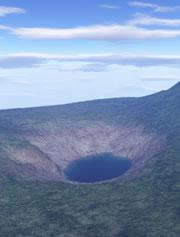 Lake Cheko: round, with a lump of something at the bottom.Gasperini, L.,
Lake Cheko: round, with a lump of something at the bottom.Gasperini, L.,After nearly 100 years of searches, researchers have found what may be an impact crater made by the object that caused a huge blast over the remote Siberian area of Tunguska on 30 June 1908.
Others caution that the identification of the crater remains to be proved, but say it could be an important discovery and merits further study.
The 1908 blast flattened trees over an area of 2,000 square kilometres and produced booming sounds, seismic effects and bright night skies through much of Europe and central Asia. Most researchers think it was caused by an incoming stony asteroid exploding about 5 to 10 kilometres above the ground as it careened through the atmosphere, producing a blast of 10 megatonnes of energy or more. That makes it the largest impact of extraterrestrial origin recorded in historic times. But numerous expeditions to the remote, unpopulated tundra region had failed to locate a crater or any fragments of the exploding object.
Now, Luca Gasperini from the Institute of Marine Science in Bologna, Italy, and others say that a nearly circular lake called Lake Cheko may be a crater left by a remnant from that blast.
The team used seismic profiling, sonar and core sampling of bottom sediments to characterize the lake, which is about 8 kilometres from the epicentre of the explosion. The 300-metre-wide lake has a highly unusual steep funnel-shaped profile, unlike other lakes in the region, and plunges down to a depth of 50 metres.
In a paper published in the journal Terra Nova1, Gasperini and his colleagues say the shape "is different from that of subarctic Siberian thermokarst lakes, and is also hard to be accounted for by other 'normal' Earth-surface tectonic or erosion/deposition processes, but is compatible with the impact of a cosmic body."
Intriguingly, the team detected a lump of concentrated mass about 10 metres below the sediments in the centre of the lake, which they think may be the fragment that hit Earth. They plan to return next summer to drill deeper into the lake bottom, in hopes of recovering samples of the buried object.
Lumpy bits
The study of this impact is important, says David Morrison, a planetary scientist at NASA's Ames Research Center in Mountain View, California, who specializes in asteroid impacts. "It's the only historical example we have of a multi-megatonne explosion," he says. And that's the "most likely size" of a devastating impact that might occur in the future, he adds.
But, he says, at this point the identification of the crater "is just a suggestion", with no hard evidence as yet to support an extraterrestrial origin.
If it is confirmed, it would indicate that the event happened a bit differently to how models have shown. In simulations, such mid-air explosions generally leave only small fragments — smaller than would be required to produce a crater of this size. But Morrison suggests that larger pieces might result if the object was made of clumps of different types of material with different physical properties, as many asteroids are thought to be.
ADVERTISEMENT
"We don't have a lot of experience with what happens in that size range of impactors," says Alan Harris of the Space Science Institute in Boulder, Colorado. "It's a fascinating concept, and it would be really interesting if they dig down and find the cosmic body."
The claim that Lake Cheko may be an impact crater is a reasonable one, says asteroid specialist Richard Binzel of the Massachusetts Institute of Technology. "People are taking it seriously," he says. "I say go for it: go drill."
Visit our candidatespottedintu.html">newsblog to read and post comments about this story.
